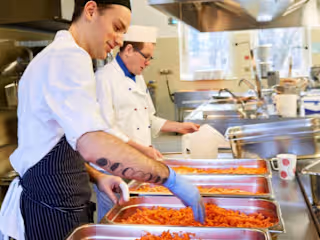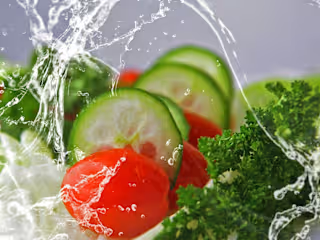Basic Food Hygiene Course: The First Step to a Safe Food Career

Basic Food Hygiene Course: The First Step to a Safe Food Career
If you are planning to work in the food and beverage (F&B) industry, the first requirement is very simple — learn how to keep food safe and clean. This is exactly what the Basic Food Hygiene Course is designed for.
Whether you're joining a restaurant, hawker stall, catering company, hotel kitchen, or bakery, understanding how to handle food safely is not just important — it's compulsory in many countries. In places like Singapore, the Basic Food Hygiene Course is a government-approved training that every food handler must complete before starting work.
In this article, we’ll explain everything about the Basic Food Hygiene Course — what it is, who needs it, what you will learn, how to register, and how it helps your career in food services.
What is a Basic Food Hygiene Course?
A Basic Food Hygiene Course is a short training program that teaches workers how to keep food safe from contamination. It covers key hygiene topics such as handwashing, food storage, cooking temperatures, personal cleanliness, and cleaning equipment.
This course is meant for beginners — especially those who have never worked in food handling before. Once you complete the course and pass the test, you receive a certification that proves you are qualified to handle food safely in your job.
In many countries, this course is also called Food Safety Course Level 1.
Who Needs to Take a Basic Food Hygiene Course?
If your job involves touching or handling food, you need to take this course. This includes:
Kitchen helpers
Food stall workers
Cooks and chefs
Hawkers
Food packers
Bakery staff
Juice and drink stall workers
Food delivery personnel (if handling open or unpackaged food)
Waiters handling food trays or buffets
Even part-time or temporary workers must complete this course before starting work in the food business.
Why is the Basic Food Hygiene Course Important?
Unsafe food can lead to food poisoning, sickness, and even death in serious cases. The Basic Food Hygiene Course teaches you how to prevent this.
Here’s why this course matters:
✅ Protects Customers:
Clean food means safe food. If food is handled wrongly, it can cause diseases like diarrhea, vomiting, or foodborne infections.
✅ Required by Law:
Many governments and food safety agencies make it mandatory for all food handlers to complete this training.
✅ Job Requirement:
Most employers in restaurants, cafes, and food courts won’t hire anyone without a valid food hygiene certificate.
✅ Better Work Performance:
Knowing the right way to wash hands, store ingredients, and clean surfaces makes you faster, safer, and more confident at your job.
What You Will Learn in the Basic Food Hygiene Course
This course is designed to teach everything you need to know to start working safely with food. The key modules usually include:
🔹 Personal Hygiene:
Proper handwashing steps
Why personal cleanliness matters
When to wear gloves and masks
🔹 Safe Food Handling:
Handling raw and cooked food separately
Using clean tools and surfaces
Safe cooking and reheating temperatures
🔹 Food Storage:
Right storage temperatures (cold and hot)
FIFO system (First In, First Out)
How to label and date stored food
🔹 Cross-Contamination Prevention:
Keeping raw meat away from vegetables
Cleaning cutting boards and knives
Using color-coded tools
🔹 Cleaning and Sanitising:
How to clean kitchen tools properly
Types of sanitisers used
Cleaning frequency and schedules
🔹 Understanding Foodborne Illnesses:
What causes food poisoning
Symptoms to watch for
Reporting health problems while working
All of these topics are taught in a simple, practical way, so even first-timers can understand easily.
Duration and Format of the Course
The Basic Food Hygiene Course is usually a 1-day training, lasting 8 to 9 hours, including:
Classroom-style teaching
Video demonstrations
Group discussions
Simple quizzes
Hands-on hygiene practice
The course is usually conducted in various languages like English, Mandarin, Tamil, or Malay — depending on the training centre.
Assessment and Certification
After completing the training, you will need to take an assessment test, which usually includes:
Written Test: Multiple-choice or short questions
Practical Test: Demonstrating correct handwashing, food handling, or cleaning steps
You must pass both parts to get your Basic Food Hygiene Certificate. Once you pass, you’ll receive a physical or digital certificate that is valid for several years.
Validity of the Certificate
The certificate is generally valid for 5 years from the date of issue. After that, you need to attend a Refresher Food Hygiene Course to continue working legally in the food industry.
If your certificate expires, some employers may not allow you to continue food handling duties.
Course Fees
The price of the Basic Food Hygiene Course depends on the training provider. On average, it costs around:
$130 to $160 for the full course (including test and certificate)
Subsidies: In countries like Singapore, locals can use SkillsFuture Credit or get government subsidies to lower the cost
Some companies also pay the fee for their staff as part of training
Eligibility Criteria
There are no strict educational qualifications needed. However, you must:
Be at least 16 years old
Be physically able to perform simple food tasks
Understand the language in which the course is being conducted
Some training centres may also require you to bring a valid ID (like NRIC, passport, or work permit).
How to Register for the Course
Follow these simple steps:
Choose a Training Provider: Look for one that is recognised by your country’s food agency
Check Course Dates: Select a date and time that suits your schedule
Register: Fill out a registration form online or in person
Pay the Fee: Make the payment online, or confirm if your company is paying
Attend the Training: Go to the centre on the given date
Take the Test and Get Certified
Benefits of the Basic Food Hygiene Course
Let’s break it down clearly:
✅ Legal Approval – You’re now eligible to work in any food outlet
✅ Higher Chances of Employment – Most hiring managers check for certification first
✅ Confidence in the Kitchen – You’ll know how to avoid mistakes that lead to food contamination
✅ Better Job Performance – Clean work is smart work
✅ Respect from Employers – Certified staff are trusted more
For food business owners, having certified staff also helps maintain good hygiene grades and avoid government penalties.
When to Take a Refresher Course
You should take a refresher course:
Before your certificate expires (within 5 years)
If you change jobs and your new employer requests updated training
If food hygiene laws or guidelines are updated
The refresher course is shorter, usually 4 hours, and focuses on updates and revision.
Final Thoughts
The Basic Food Hygiene Course is your ticket to entering the food and beverage industry safely and confidently. It's a simple, short, and affordable course — but the benefits last for years. Whether you’re just starting your food career or switching roles, this training gives you the essential knowledge to keep food safe and clean for everyone.
Don’t treat this course like a formality. It’s your duty as a food handler to keep customers healthy and happy. With just one day of training, you’ll gain valuable skills that help you work better, stay safe, and grow your career in food service.
Like this project
Posted May 15, 2025
Basic Food Hygiene Course teaches safe food handling for F&B industry.
Likes
0
Views
0







